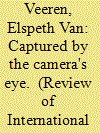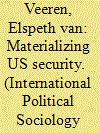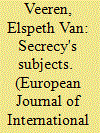|
|
|
Sort Order |
|
|
|
Items / Page
|
|
|
|
|
|
|
| Srl | Item |
| 1 |
ID:
114985


|
|
|
|
|
| Publication |
2011.
|
| Summary/Abstract |
In January 2002, images of the detention of prisoners held at US Naval Station Guantanamo Bay as part of the Global War on Terrorism were released by the US Department of Defense, a public relations move that Secretary of Defense Donald Rumsfeld later referred to as 'probably unfortunate'. These images, widely reproduced in the media, quickly came to symbolise the facility and the practices at work there. Nine years on, the images of orange-clad 'detainees' - the 'orange series' - remain a powerful symbol of US military practices and play a significant role in the resistance to the site. However, as the site has evolved, so too has its visual representation. Official images of these new facilities not only document this evolution but work to constitute, through a careful (re)framing (literal and figurative), a new (re)presentation of the site, and therefore the identities of those involved. The new series of images not only (re)inscribes the identities of detainees as dangerous but, more importantly, work to constitute the US State as humane and modern. These images are part of a broader effort by the US administration to resituate its image, and remind us, as IR scholars, to look at the diverse set of practices (beyond simply spoken language) to understand the complexity of international politics.
|
|
|
|
|
|
|
|
|
|
|
|
|
|
|
|
| 2 |
ID:
130985


|
|
|
|
|
| Publication |
2014.
|
| Summary/Abstract |
While a growing body of literature working at the intersection of security and visual studies recognizes the value of studying images, how these visualities are produced is less theorized, especially with respect to materialities and their capacity to compel meanings. Analyzing the tours of Joint Task Force Guantanamo, which have been arranged by the US military for VIP visitors since the site opened, this article argues that the selective organization and presentation of specific matter was image-making and therefore meaning-making. Through efforts to produce a spectacle of detention, Guantánamo was deliberately constructed as "safe, humane, legal, transparent"-in the process shifting the meaning of these very concepts. Guantánamo's tours as visual and material practices were therefore used to produce meaning in the debate over the future of the site and how best to secure the US state post-9/11. They were part of the constitution of the war's legitimacy, leading, ultimately, to certain understandings of security. Guantánamo, with its "object lessons" and "concrete messages," is therefore a useful case study for understanding security meaning-making as produced by the interaction of linguistic, visual, and material domains and their elements.
|
|
|
|
|
|
|
|
|
|
|
|
|
|
|
|
| 3 |
ID:
169166


|
|
|
|
|
| Summary/Abstract |
This article sets out a framework for studying the power of secrecy in security discourses. To date, the interplay between secrecy and security has been explored within security studies most often through a framing of secrecy and security as a ‘balancing’ act, where secrecy and revelation are binary opposites, and excesses of either produce insecurity. Increasingly, however, the co-constitutive relationship between secrecy and security is the subject of scholarly explorations. Drawing on ‘secrecy studies’, using the US ‘shadow war’ as an empirical case study, and conducting a close reading of a set of key memoirs associated with the rising practice of ‘manhunting’ in the Global War on Terrorism (GWoT), this article makes the case that to understand the complex workings of power within a security discourse, the political work of secrecy as a multilayered composition of practices (geospatial, technical, cultural, and spectacular) needs to be analysed. In particular, these layers result in the production and centring of several secrecy subjects that help to reproduce the logic of the GWoT and the hierarchies of gender, race, and sex within and beyond special operator communities (‘insider’, ‘stealthy’, ‘quiet’, and ‘alluring’ subjects) as essential to the security discourse of the US ‘shadow war’.
|
|
|
|
|
|
|
|
|
|
|
|
|
|
|
|
|
|
|
|
|